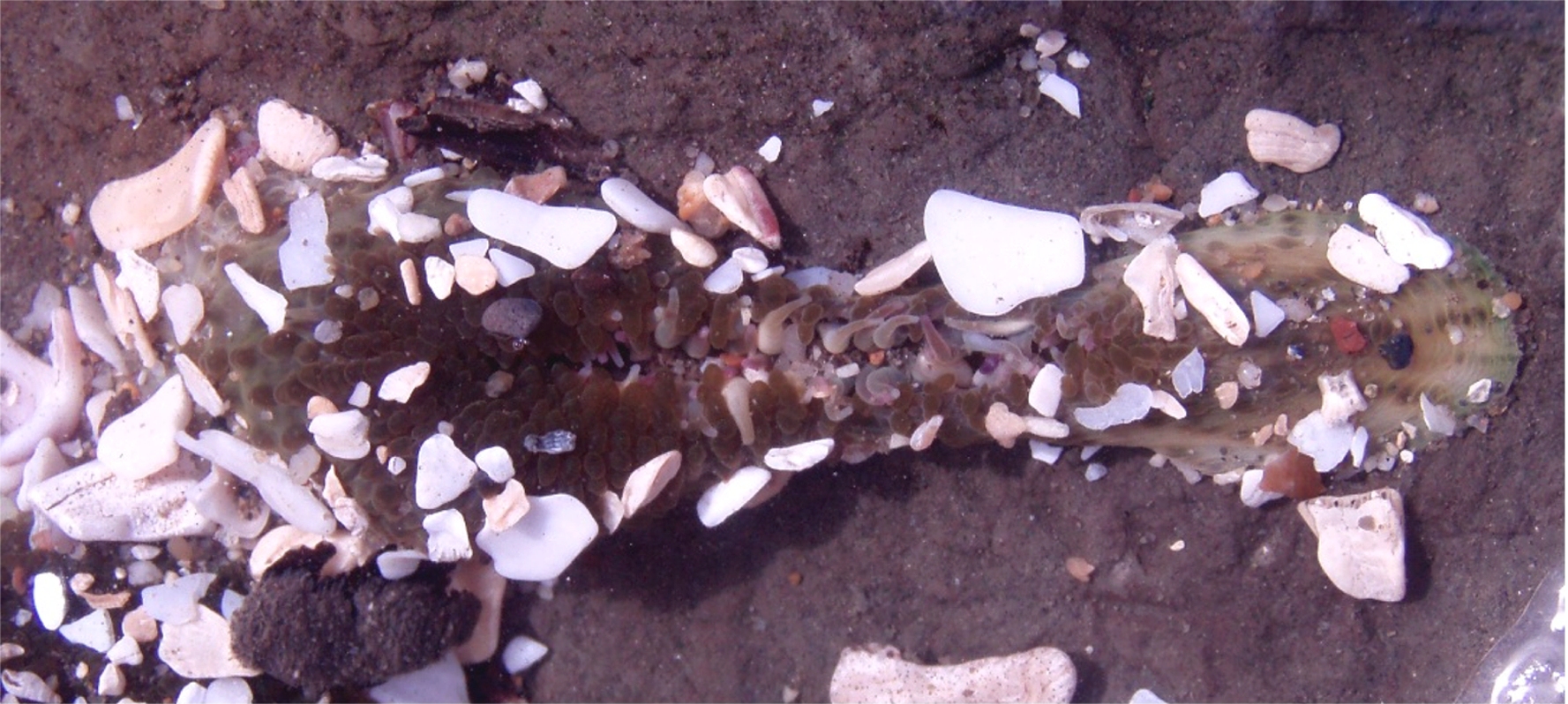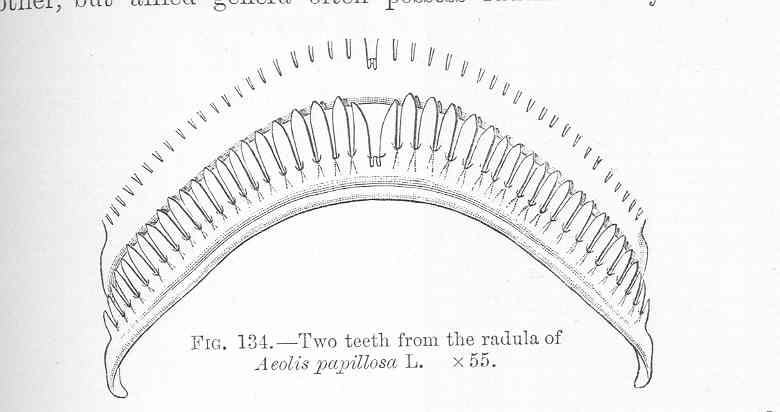|
Aggregating Anemone
The aggregating anemone (''Anthopleura elegantissima''), or clonal anemone, is the most abundant species of sea anemone found on rocky, tide swept shores along the Pacific coast of North America. This cnidarian hosts endosymbiotic algae called zooxanthellae that contribute substantially to primary productivity in the intertidal zone. The aggregating anemone has become a model organism for the study of temperate cnidarian-algal symbioses. Description The polyps of the aggregating anemone reach up to eight cm across the oral disk with approximately 100 tentacles in three or four rows around the margins of the oral disk. Most are olive to bright green (depending on the species of algal symbionts present) with tentacles tipped in pink. Individuals that live in microhabitats that are deficient in photosynthetically active radiation (PAR), such as under docks or in caves, lack symbionts and are pale yellow to white in color. Range Pacific coast of North America from Alaska, Uni ... [...More Info...] [...Related Items...] OR: [Wikipedia] [Google] [Baidu] |
Johann Friedrich Von Brandt
Johann Friedrich von Brandt (25 May 1802 – 15 July 1879) was a German-Russian naturalist, who worked mostly in Russia. Brandt was born in Jüterbog and educated at a gymnasium in Wittenberg and the University of Berlin. In 1831 he emigrated to Russia, and soon was appointed director of the Zoological Museum of the St Petersburg Academy of Sciences. Brandt encouraged the collection of native animals, many of which were not represented in the museum. Many specimens began to arrive from the expeditions of Severtzov, Przhevalsky, Middendorff, Schrenck and Gustav Radde. He described several birds collected by Russian explorers off the Pacific Coast of North America, including Brandt's cormorant, red-legged kittiwake and spectacled eider. As a paleontologist, Brandt ranks among the best. He was also an entomologist, specialising in Coleoptera (beetles) and Diplopoda (millipedes). He died in Merreküll, Governorate of Estonia. He is also commemorated in Brandt's ba ... [...More Info...] [...Related Items...] OR: [Wikipedia] [Google] [Baidu] |
Leather Star
The leather star (''Dermasterias imbricata'') is a sea star in the family Asteropseidae found at depths to off the western seaboard of North America. It was first described to science by Adolph Eduard Grube in 1857. Description The leather star has a broad central disc and five plump, short arms which taper broadly from the central disc. The arms have two rows of tube feet and no bordering marginal plates. The upper, aboral, surface is smooth and velvety, made more so by the absence of spines and a light layer of mucous. It is covered with a reticulated pattern in reddish-brown, often with patches of greyish-blue. No pedicellariae are present, but the madreporite can be seen. This starfish can grow to about in diameter and has a distinctive smell that resembles garlic and sulphur.Marine Biodiversity of British Columbia< ... [...More Info...] [...Related Items...] OR: [Wikipedia] [Google] [Baidu] |
Aeolidia Papillosa
''Aeolidia papillosa'', known as the common grey sea slug, is a species of nudibranch in the family Aeolidiidae.Gofas, S''Aeolidia papillosa''.In: MolluscaBase (2017). Accessed through: World Register of Marine Species (WoRMS), 26 July 2017. Distribution This nudibranch species thrives in cold-temperate waters in the Northern Hemisphere on the Atlantic coast of The British Isles and Northern Europe, the Atlantic coast of North America, and the north Pacific Coast of North America. This species has recently been shown to have a more restricted distribution than previously thought, with animals from California, France and Chile being three other species. Description ''Aeolidia papillosa'' can be easily identified by its large number of cylindrical cerata covering its body except for a triangular area that extends from the rhinophores to the mid dorsum. The color is variable, usually with speckled darker markings in the head and back regions. To distinguish from different Aeo ... [...More Info...] [...Related Items...] OR: [Wikipedia] [Google] [Baidu] |
Ectoderm
The ectoderm is one of the three primary germ layers formed in early embryonic development. It is the outermost layer, and is superficial to the mesoderm (the middle layer) and endoderm (the innermost layer). It emerges and originates from the outer layer of germ cells. The word ectoderm comes from the Greek ''ektos'' meaning "outside", and ''derma'' meaning "skin".Gilbert, Scott F. Developmental Biology. 9th ed. Sunderland, MA: Sinauer Associates, 2010: 333-370. Print. Generally speaking, the ectoderm differentiates to form epithelial and neural tissues (spinal cord, peripheral nerves and brain). This includes the skin, linings of the mouth, anus, nostrils, sweat glands, hair and nails, and tooth enamel. Other types of epithelium are derived from the endoderm. In vertebrate embryos, the ectoderm can be divided into two parts: the dorsal surface ectoderm also known as the external ectoderm, and the neural plate, which invaginates to form the neural tube and neural cr ... [...More Info...] [...Related Items...] OR: [Wikipedia] [Google] [Baidu] |
Nematocytes
A cnidocyte (also known as a cnidoblast or nematocyte) is an explosive cell containing one large secretory organelle called a cnidocyst (also known as a cnida () or nematocyst) that can deliver a sting to other organisms. The presence of this cell defines the phylum Cnidaria (corals, sea anemones, hydrae, jellyfish, etc.). Cnidae are used to capture prey and as a defense against predators. A cnidocyte fires a structure that contains a toxin within the cnidocyst; this is responsible for the stings delivered by a cnidarian. Structure and function Each cnidocyte contains an organelle called a cnida, cnidocyst, nematocyst, ptychocyst or spirocyst. This organelle consists of a bulb-shaped capsule containing a coiled hollow tubule structure attached to it. An immature cnidocyte is referred to as a cnidoblast or nematoblast. The externally oriented side of the cell has a hair-like trigger called a cnidocil, which is a mechano- and chemo-receptor. When the trigger is activated, t ... [...More Info...] [...Related Items...] OR: [Wikipedia] [Google] [Baidu] |
Clone War Of Sea Anemones 2-17-08-2 Edit1
Clone or Clones or Cloning or Cloned or The Clone may refer to: Places * Clones, County Fermanagh * Clones, County Monaghan, a town in Ireland Biology * Clone (B-cell), a lymphocyte clone, the massive presence of which may indicate a pathological condition * Clone (cell biology), a group of identical cells that share a common ancestry * Clonal plant, the result of asexual, vegetative reproduction when a new plant grows from a fragment of the parent plant * Cloning, the production of any organism whose genetic information is identical to that of a parent organism from which it was created Computing and technology * Clone (computing), computer hardware or software designed to function in the same way as an original ** Video game clone, a software game or game franchise heavily inspired by another ** ''Clones'' (video game), a video game clone ''Lemmings'' * Clone (Java method), a method in the Java programming language for object duplication * Clone (Linux system call), in C, w ... [...More Info...] [...Related Items...] OR: [Wikipedia] [Google] [Baidu] |
Antioxidant
Antioxidants are compounds that inhibit oxidation, a chemical reaction that can produce free radicals. This can lead to polymerization and other chain reactions. They are frequently added to industrial products, such as fuels and lubricants, to prevent oxidation, and to foods to prevent spoilage, in particular the rancidification of oils and fats. In cells, antioxidants such as glutathione, mycothiol or bacillithiol, and enzyme systems like superoxide dismutase, can prevent damage from oxidative stress. The only dietary antioxidants are vitamins A, C, and E, but the term ''antioxidant'' has also been applied to numerous other dietary compounds that only have antioxidant properties in vitro, with little evidence for antioxidant properties in vivo. Dietary supplements marketed as antioxidants have not been shown to maintain health or prevent disease in humans. History As part of their adaptation from marine life, terrestrial plants began producing non-marine a ... [...More Info...] [...Related Items...] OR: [Wikipedia] [Google] [Baidu] |
Ultraviolet Radiation
Ultraviolet (UV) is a form of electromagnetic radiation with wavelength from 10 nm (with a corresponding frequency around 30 PHz) to 400 nm (750 THz), shorter than that of visible light, but longer than X-rays. UV radiation is present in sunlight, and constitutes about 10% of the total electromagnetic radiation output from the Sun. It is also produced by electric arcs and specialized lights, such as mercury-vapor lamps, tanning lamps, and black lights. Although long-wavelength ultraviolet is not considered an ionizing radiation because its photons lack the energy to ionize atoms, it can cause chemical reactions and causes many substances to glow or fluoresce. Consequently, the chemical and biological effects of UV are greater than simple heating effects, and many practical applications of UV radiation derive from its interactions with organic molecules. Short-wave ultraviolet light damages DNA and sterilizes surfaces with which it comes into contact. For h ... [...More Info...] [...Related Items...] OR: [Wikipedia] [Google] [Baidu] |
Euphotic
The photic zone, euphotic zone, epipelagic zone, or sunlight zone is the uppermost layer of a body of water that receives sunlight, allowing phytoplankton to perform photosynthesis. It undergoes a series of physical, chemical, and biological processes that supply nutrients into the upper water column. The photic zone is home to the majority of aquatic life due to the activity (primary production) of the phytoplankton. Photosynthesis in photic zone In the photic zone, the photosynthesis rate exceeds the respiration rate. This is due to the abundant solar energy which is used as an energy source for photosynthesis by primary producers such as phytoplankton. These phytoplankton grow extremely quickly because of sunlight's heavy influence, enabling it to be produced at a fast rate. In fact, ninety five percent of photosynthesis in the ocean occurs in the photic zone. Therefore, if we go deeper, beyond the photic zone, such as into the compensation point, there is little to no p ... [...More Info...] [...Related Items...] OR: [Wikipedia] [Google] [Baidu] |
Carbon Dioxide
Carbon dioxide ( chemical formula ) is a chemical compound made up of molecules that each have one carbon atom covalently double bonded to two oxygen atoms. It is found in the gas state at room temperature. In the air, carbon dioxide is transparent to visible light but absorbs infrared radiation, acting as a greenhouse gas. It is a trace gas in Earth's atmosphere at 421 parts per million (ppm), or about 0.04% by volume (as of May 2022), having risen from pre-industrial levels of 280 ppm. Burning fossil fuels is the primary cause of these increased CO2 concentrations and also the primary cause of climate change.IPCC (2022Summary for policy makersiClimate Change 2022: Mitigation of Climate Change. Contribution of Working Group III to the Sixth Assessment Report of the Intergovernmental Panel on Climate Change Cambridge University Press, Cambridge, United Kingdom and New York, NY, USA Carbon dioxide is soluble in water and is found in groundwater, lakes, ice ca ... [...More Info...] [...Related Items...] OR: [Wikipedia] [Google] [Baidu] |
Mutualism (biology)
Mutualism describes the ecological interaction between two or more species where each species has a net benefit. Mutualism is a common type of ecological interaction. Prominent examples include most vascular plants engaged in mutualistic interactions with mycorrhizae, flowering plants being pollinated by animals, vascular plants being dispersed by animals, and corals with zooxanthellae, among many others. Mutualism can be contrasted with interspecific competition, in which each species experiences ''reduced'' fitness, and exploitation, or parasitism, in which one species benefits at the expense of the other. The term ''mutualism'' was introduced by Pierre-Joseph van Beneden in his 1876 book ''Animal Parasites and Messmates'' to mean "mutual aid among species". Mutualism is often conflated with two other types of ecological phenomena: cooperation and symbiosis. Cooperation most commonly refers to increases in fitness through within-species (intraspecific) interactions, alth ... [...More Info...] [...Related Items...] OR: [Wikipedia] [Google] [Baidu] |

_(cropped).jpg)




